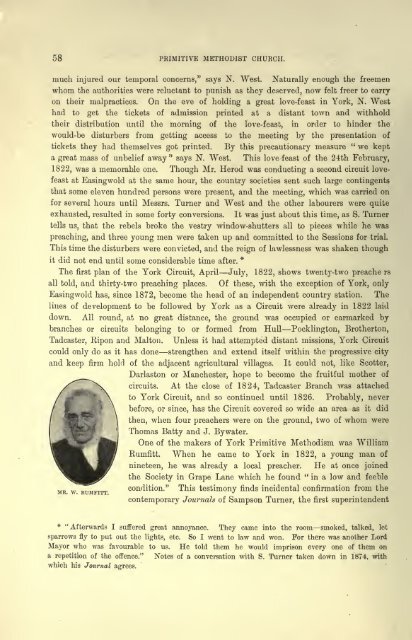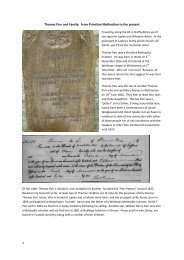Vol 2, pages 1-100 - My Primitive Methodist Ancestors
Vol 2, pages 1-100 - My Primitive Methodist Ancestors
Vol 2, pages 1-100 - My Primitive Methodist Ancestors
You also want an ePaper? Increase the reach of your titles
YUMPU automatically turns print PDFs into web optimized ePapers that Google loves.
58 PRIMITIVE METHODIST CHURCH.<br />
much injured our temporal concerns," says N. West. Naturally enough the freemen<br />
whom the authorities were reluctant to punish as they deserved, now felt freer to carry<br />
on their malpractices. On the eve of holding a great love-feast in York, N. West<br />
had to get the tickets of admission printed at a distant town and withhold<br />
their distribution until the morning of the love-feast, in order to hinder the<br />
would-be disturbers from getting access to the meeting by the presentation of<br />
tickets they had themselves got printed. By this precautionary measure " we kept<br />
a great mass of unbelief away" says N. West. This love -feast of the 24th February,<br />
1822, was a memorable one. Though Mr. Herod was conducting a second circuit lovefeast<br />
at Easingwold at the same hour, the country societies sent such large contingents<br />
that some eleven hundred persons were present, and the meeting, which was carried on<br />
for several hours until Messrs. Turner and West and the other labourers were quite<br />
exhausted, resulted in some forty conversions. It was just about this time, as S. Turner<br />
tells us, that the rebels broke the vestry window-shutters all to pieces while he was<br />
and committed to the Sessions for trial.<br />
preaching, and three young men were taken up<br />
This time the disturbers were convicted, and the reign of lawlessness was shaken though<br />
it did not end until some considerable time after. *<br />
The first plan of the York Circuit, April July, 1822, shows twenty -two preache rs<br />
all told, and thirty-two preaching places. Of these, with the exception of York, only<br />
Easingwold has, since 1872, become the head of an independent country station. The<br />
lines of development to be followed by York as a Circuit were already in 1822 laid<br />
down. All round, at no great distance, the ground was occupied or earmarked by<br />
branches or circuits belonging to or formed from Hull Pocklington, Brotherton,<br />
Tadcaster, Ripon and Mai ton. Unless it had attempted distant missions, York Circuit<br />
could only do as it has done strengthen and extend itself within the progressive city<br />
and keep firm hold of the adjacent agricultural villages. It could not, like Scotter,<br />
MK. W. K UM Fill'.<br />
Darlaston or Manchester, hope<br />
to become the fruitful mother of<br />
circuits. At the close of 1824, Tadcaster Branch was attached<br />
to York Circuit, and so continued until 1826. Probably, never<br />
before, or since, has the Circuit covered so wide an area as it did<br />
then, when four preachers were on the ground, two of whom were<br />
Thomas Batty and J. Bywater.<br />
One of the makers of York <strong>Primitive</strong> Methodism was William<br />
Rumfitt. When he came to York in 1822, a young man of<br />
nineteen, he was already a local preacher. He at once joined<br />
the Society in Grape Lane which he found " in a low and feeble<br />
condition."<br />
This testimony finds incidental confirmation from the<br />
contemporary Journals of Sampson Turner, the first superintendent<br />
* "Afterwards I suffered great annoyance. They came into the room smoked, talked, let<br />
sparrows fly to put out the lights, etc. So I went to law and won. For there was another Lord<br />
Mayor who was favourable to us. He told them he would imprison every one of them on<br />
a repetition of the offence." Notes of a conversation with S. Turner taken down in 1874, with<br />
which his Journal agrees.



